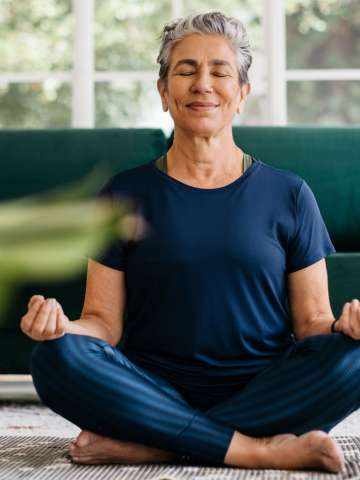Body Well-being: Mindfulness & Breathwork
Meditation, breathwork and the body/mind connection
To help you optimize your wellness, we offer workshops and support groups that incorporate meditation and breathwork practices. These workshops have been shown to reduce stress and anxiety, increase energy and encourage people to feel more present and grounded. Many of the practices we use help participants view the challenges of cancer differently.

Every week, our compassionate and experienced team members walk you through your journey. We’re by your side every step of the way to provide guidance and support.
How mindfulness and breathwork can help people with cancer
A cancer diagnosis often comes with anxiety, worry and even anger. During this stressful time, you may feel overwhelmed and distracted. Practicing mindfulness helps you connect with the present moment, calms your mind and improves your focus.
Being present means taking the time to become more aware of what’s happening emotionally and physically in this moment, without worrying about what will happen in the future. By anchoring yourself in the present, you’ll gain a greater sense of stability, even amid uncertainty.
Breathwork includes several breathing techniques that can calm the nervous system, control anxiety and help you relax. Using various techniques, an instructor shows you how to control your breathing, breathe more deeply and become more aware of inhaling and exhaling.
When used together, mindfulness meditation and breathing techniques complement each other. These practices go together, enabling you to feel more relaxed, centered and in control as you navigate your cancer journey.
Mindfulness Meditation Support Group
Led by an oncology social worker, this support group is designed to help people with cancer and their loved ones. We focus on a different theme each week, exploring how increasing mindfulness can help you:
- Manage depression and anxiety
- Cope with grief
- Improve your overall well-being
We use several modalities, practices and exercises, including guided meditation and breathwork. At the end of the session, we open the discussion and encourage people to share their experiences. This part of the support group allows participants to feel connected as they support each other.
Breathwork Support Group
At this weekly support group, a certified yoga instructor guides participants through a breath journey designed to manage stress and anxiety, reduce fear and improve mood. We encourage participants to embrace and explore these emotions.
Using calming music and somatic breathing techniques, we help you become more aware of each breath you take, how the air flows through your body and how that makes you feel. Breathing techniques can calm the nervous system and assist with managing pain.

We give you techniques, tips and tricks to use in stressful situations. One of the practices we use is called alternate nostril breathing. To do this, gently close one nostril with your finger or thumb. Inhale and exhale a few times through the open nostril, then switch nostrils, keeping the other one closed for a few breaths. This practice helps you focus on breathing and has been shown to reduce stress and restore energy and focus.
Our breathwork practices are customized based on each person’s type of cancer, symptoms and abilities. We also incorporate guided meditation into the workshop. Following the breathwork portion of the workshop, we open the room for reflection.
5-4-3-2-1 mindfulness exercise
One of the practices we use during support groups is the 5-4-3-2-1 mindfulness exercise. This technique uses your five senses to help you find your ground in the present moment. Begin by taking gentle, slow, deep breaths in through your nose and out through your mouth. As you breathe in, slowly count to four. As you exhale, count to four again. Repeat this breathing a few times.
5. Seeing: Now, look around and notice five objects you see in the environment around you. What is the color and texture of each object? See the object and focus any internal commentary on how it appears to you visually.
4. Touching: Use your sense of touch to feel four different sensations. You can touch your skin, clothing, a nearby object or the seat you’re sitting on. Notice how that object feels in your hand or on your fingers. Is it smooth, rough, coarse, hot, warm or cold? Simply be with the sense of touch.
3. Hearing: Pause and listen for sounds you hear. Focus on one sound at a time as you notice three distinct sounds. Perhaps you hear the noise from a fan or air conditioner. Maybe you hear your own breathing or the sound of birds or traffic. Listen to each sound as it is, being like an antenna that is receiving the sound clearly.

2. Smell: Notice two things you can smell. Perhaps there is already a scent in your environment you can notice. Or perhaps the lingering smell of soap on your hands or shampoo in your hair – whatever scent may be present. Notice the smell itself as it is.
1. Taste: Notice one thing you can taste. If you have a cup of tea or coffee, or a small piece of food nearby, you can taste this as an example. If you currently lack a sense of taste, you can notice the absence of taste. What does it feel like when there is no taste? Sense the taste with curiosity.
Complete the exercise with one deep breath. As you continue your day, try to carry with you this sense of connectedness with the present moment.
